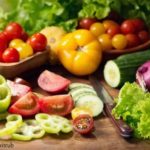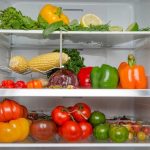Gracie's Kitchen prepared produce is being recalled for possible Listeria monocytogenes contamination. No illnesses have been reported to the company to date in connection with the consumption of these items. The recalling firm is Gracie's Kitchen of New Haven, Connecticut. These items were sold in grocery stores in the states of Connecticut and New York. The product sell by dates are between November 9, 2024 to November 24, 2024. These products are no longer available for sale, and are past their sell by dates, but consumers may still have them in their homes. You can see the long list of recalled products, along with the UPC numbers, pack size, type of packaging, and sell by dates, at the FDA web site. Some of the recalled Gracie's Kitchen prepared produce items are Peppers … [Read more...]
Consumer Reports Tracks Pesticides on Fresh Produce
Consumer Reports tracks pesticides on produce and has released the results of their research. They say that since the 1960s, some chemicals used on American crops have unacceptable health risks. Some pesticides are banned in the United States, but the government has been slow to act on banning others. And when a chemical is removed from the market, companies and growers may use others that can be just as hazardous to your health. Consumer Reports conducted a comprehensive review of pesticides in food by analyzing seven years of data from the Department of Agriculture. Every year, that agency tests a selection of conventionally grown and organic produce that is grown in the U.S. or imported. CR looked at 59 common fruits and vegetables, including the fresh version, canned, dried, and … [Read more...]
Environmental Working Group Publishes Dirty Dozen Produce List
The Environmental Working Group has published their Dirty Dozen Produce List and their Clean Fifteen list for 2022, with the top 12 fruits and vegetables that are most likely to be contaminated with pesticides and the top 15 that are least likely to be contaminated. The report states that more than 705 of non-organic fresh produce sold in the United States contains residues of potentially harmful pesticides. The guide analyzes the latest test data from the USDA and FDA. It also found that more than 50% of potatoes, spinach, lettuce, and eggplant had detectable levels of at least one of three bee-killing nemonic insecticides that are banned in the EU but still allowed in the U.S. The USDA washes, peels, or scrubs the fruits and vegetables before testing, so those actions will not … [Read more...]
FDA’s Food Safety and Nutrition Survey Report Released
The FDA's Food Safety and Nutrition Survey, the agency's probability consumer survey designed to assess consumer awareness, knowledge, understanding, and self-reported behaviors regarding food safety, has been released for 2019. The survey was launched to help the FDA make informed regulatory, education, and policy decisions to protect public health. The survey was a mail-push to web methodology. The population includes adults who live in the 50 U.S. states and the District of Columbia. A total of 4,398 responses were collected during ht months of October and November 2019. Before this methodology change, FDA consumer surveys were conducted using phone interviews. The key findings on food safety include consumer knowledge about where they think they may contract food poisoning, … [Read more...]
Washington E. coli Outbreak Spreads to Four Counties, at Least Six Sick
The Washington E. coli outbreak has now spread to four counties with at least six confirmed cases, according to the Washington State Department of Health (DOH). This E. coli O157:H7 outbreak may be linked to fresh produce. The official case count stands at six, even though the individual county health departments are reporting higher totals. King County says it has seven cases, while Snohomish County claims two. Benton and Walla Walla Counties claim four patients, for a total of 13 patients. The difference is that the Washington DOH only reports confirmed cases infected with E. coli O157:H7 that have been genetically linked, while the cases the counties are reporting may still be under investigation. In the official state case count, there is one case between the ages of 0 and 9, … [Read more...]
How to Clean Fresh Fruits and Vegetables To Protect Yourself
As we head into the summer months in the Northern hemisphere, people start eating more fresh fruits and vegetables. And unfortunately, every year there are outbreaks linked to those products, from cyclospora to E. coli. As a matter of fact, fresh produce is one of the main ways people get sick from food poisoning, and one of the major causes of multistate food poisoning outbreaks. From Salmonella on peaches to E. coli on romaine lettuce to cyclospora on basil, these foods sicken thousands of people every year. While it's not possible to make these foods completely safe without cooking them to 165°F, you can reduce your risk by cleaning them properly before preparation. First, do not use soap or bleach or other disinfectants to clean fruits and vegetables. Because these items are … [Read more...]
Seven Children Sick in Seattle E. coli Outbreak: Produce Possible Source
In the Seattle E. coli outbreak that has sickened at least seven children, officials now think that some type of produce is the source of the pathogen, according to Seattle King County Public Health. The case count has not changed. All cases are under the age of 15, with three under the age of five. Officials have identified "multiple types of fresh produce, mostly organic," in most of the cases but they cannot as of yet rule out other possibilities of the source of the illnesses. The notice states, "We are still uncertain if these cases share the same source of their infection or not." All of the children have symptoms consistent with a Shiga toxin-producing E. coli (STEC) infection, which include abdominal cramps, nausea, vomiting, and diarrhea that is often bloody. Two … [Read more...]
Did You Buy Unpackaged Produce at Walmart in Andover, MN This Week?
If you purchased fresh, unpackaged produce at the Walmart Supercenter in Andover, Minnesota, at 1851 Bunker Lake Boulevard Northwest on Saturday, between 6:00 am on Sunday, June 23 and 10:30 pm on Wednesday, June 26, 2019, throw it away. The Minnesota Department of Agriculture is issuing a consumer advisory in response to a "chemical incident" that occurred at that facility on June 22, 2019 around 5:00 pm. The news release did not state what the chemical was. It only states that if you bought the food, don't eat it and throw it out.Other unpackaged foods for sale at that Walmart store were destroyed following the "incident." All fresh foods that are now for sale at this Walmart location aren't affected by this alert, according to the press release. The alert does state that "if you have … [Read more...]












